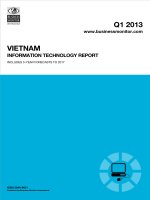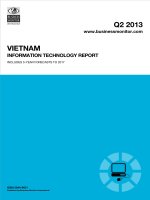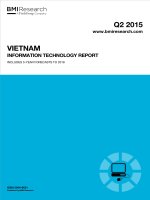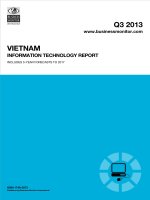United states information technology report q2 2013
Bạn đang xem bản rút gọn của tài liệu. Xem và tải ngay bản đầy đủ của tài liệu tại đây (471.13 KB, 85 trang )
Q2 2013
www.businessmonitor.com
UNITED STATES
INFORMATION TECHNOLOGY REPORT
INCLUDES 5-YEAR FORECASTS TO 2017
ISSN 2041-7101
Published by:Business Monitor International
United States Information
Technology Report Q2 2013
INCLUDES 5-YEAR FORECASTS TO 2017
Part of BMI’s Industry Report & Forecasts Series
Published by: Business Monitor International
Copy deadline: April 2013
Business Monitor International
Senator House
85 Queen Victoria Street
London
EC4V 4AB
United Kingdom
Tel: +44 (0) 20 7248 0468
Fax: +44 (0) 20 7248 0467
Email:
Web:
© 2013 Business Monitor International
All rights reserved.
All information contained in this publication is
copyrighted in the name of Business Monitor
International, and as such no part of this
publication may be reproduced, repackaged,
redistributed, resold in whole or in any part, or used
in any form or by any means graphic, electronic or
mechanical, including photocopying, recording,
taping, or by information storage or retrieval, or by
any other means, without the express written consent
of the publisher.
DISCLAIMER
All information contained in this publication has been researched and compiled from sources believed to be accurate and reliable at the time of
publishing. However, in view of the natural scope for human and/or mechanical error, either at source or during production, Business Monitor
International accepts no liability whatsoever for any loss or damage resulting from errors, inaccuracies or omissions affecting any part of the
publication. All information is provided without warranty, and Business Monitor International makes no representation of warranty of any kind as
to the accuracy or completeness of any information hereto contained.
CONTENTS
BMI Industry View 7
SWOT 9
IT SWOT 9
Political 10
Economic 11
Business Environment 12
Industry Forecast 13
Table: US IT Industry - Historical Data And Forecasts (US$mn unless otherwise stated) 15
Broadband 16
Table: Telecoms Sector - Internet - Historical Data & Forecasts 16
Macroeconomic Forecasts 19
Economic Analysis 19
GDP By Expenditure Breakdown 20
Risks To Outlook 26
Table: United States - GDP By Expenditure 27
Industry Risk Reward Ratings 28
Table: IT Risk/Reward Ratings, Q2 2013 29
Market Overview 31
Hardware 31
Software 35
Services 38
Industry Trends And Developments 41
Regulatory Development 43
Table: IT Regulatory Authorities 43
Company Profile 45
Hewlett-Packard 45
Dell 51
Table: Selected Dell Mergers And Acquisitions 54
Microsoft Corporation 57
IBM 62
Regional Overview 68
Latin America Regional Overview 68
IT Penetration 68
Market Growth And Drivers 70
United States Information Technology Report Q2 2013
© Business Monitor International Page 4
Sectors And Verticals 73
Demographic Forecast 77
Table: The United States' Population By Age Group, 1990-2020 ('000) 78
Table: The United States' Population By Age Group, 1990-2020 (% of total) 79
Table: The United States' Key Population Ratios, 1990-2020 80
Table: The United States' Rural And Urban Population, 1990-2020 80
Methodology 81
Methodology 81
IT Industry 81
IT Ratings - Methodology 82
Table: IT Business Environment Indicators 83
Weighting 84
Table: Weighting Of Components 84
Sources 84
United States Information Technology Report Q2 2013
© Business Monitor International Page 5
BMI Industry View
BMI View: US IT spending is expected to reach US$634bn in 2013, up 8.5%, with BMI leaving its
2013-2017 forecast largely unchanged, but extended, this quarter, despite a further contraction in PC sales
in H212. Meanwhile, as political negotiations concerning the 'fiscal cliff' continued in the wake of the
November 2012 elections, public IT procurements remained constrained due to the budget constraints faced
by many government entities. Overall moderate growth in budgets is expected but much depends on the
economic situation. Despite a drive to cut expenses across government, many public sector organisations
have appeared willing to continue to spend on IT, but the government hopes to make savings in its US$80bn
IT budget. US businesses remain cautious, but there is pent-up demand from projects delayed as a result of
the economic situation and cloud computing is expected to be increasingly important.
Headline Expenditure Projections
■
Computer Hardware Sales: US$153bn in 2012 to US$163bn in 2013, an increase of 6.5%. Sales of
ultrabooks and Windows 8-based tablets and notebooks have potential to provide continued growth in
2013.
■
Software Sales: US$170bn in 2012 to US$186bn in 2013, an increase of 9.4%. Forecast in US dollar
terms unchanged, but more investment is expected in utility software and serviced-orientated
architectures rather than traditionally-packaged PC software.
■
IT Services Sales: US$261bn in 2012 to US$284bn in 2013, an increase of 9.0%. Forecast in US dollar
terms unchanged with an increasing share of IT budgets earmarked for newer solutions such as
virtualisation and cloud computing.
■
Risk/Reward Ratings: The US's score was 76.3 out of 100.0. The US retains first place in our latest
Americas RRR table, ahead of Canada, as well as Latin American giants such as Brazil and Mexico. The
country's ranking was secured by its global highest industry rewards score of 82.5, with its rating also
boosted by a relatively high country rewards score of 90.0.
Key Trends & Developments
■
In late 2010, the US federal government adopted an ambitious Cloud First cloud migration strategy,
which tasked government agencies with migrating 80 services to the cloud within 18 months. The
government hopes to eventually realise savings of up to US$12bn per year from the move. This push for
web-based computing is part of a broader government effort to consolidate its 2,100 data centres by at
least 40 per cent by 2015.
■
IT vendors continue to be concerned about the effect of the ongoing US federal deficit issue, as automatic
budget enforcement procedures known as sequestration commenced on March 1 2013, after initially
being delayed from a January rollout. The sequester requires cuts in discretionary spending to achieve
$1.2 trillion in savings from 2013-2021. Major cuts to federally-funded research and development (R&D)
are already planned for 2013, and this could also hit IT projects. Given continuing split party control of
the legislative branch of government, with Republicans continuing to control Congress, and Democrats
having the majority in the Senate, the November 2012 elections have failed to resolve uncertainty about
the trajectory of future government IT spending.
United States Information Technology Report Q2 2013
© Business Monitor International Page 7
■
US PC sales are forecast to report single-digit growth in 2013, after a further annualised contraction in
Q112-Q113. In 2012, sales of ultrabooks fell far short of Intel's prediction that ultrabooks would
comprise 40% of US notebook sales by the end of 2012. While exact sales figures were hard to arrive at,
due to initially high prices, these devices therefore seem unlikely to enjoy hoped-for success, at least
initially. In the US, in H112 the average market price for an ultrabook was upwards of US$900,
compared with an average of around US$500 for a Windows notebook.
United States Information Technology Report Q2 2013
© Business Monitor International Page 8
SWOT
IT SWOT
SWOT Analysis
Strengths
■
The largest IT market in the world, with spending forecast to reach nearly US$850bn
by 2017.
■
Despite the challenging trading conditions, overall IT spending is still expected to
remain in positive growth territory.
Weaknesses
■
Due to the recession and subsequent slow economic recovery, customers postponed
IT investments and reduced short-term spending, particularly in areas such as
consulting and software development.
■
PC market appears to be in long-term decline due the preference for mobility and the
popularity of alternative connectivity devices such as smartphones.
Opportunities
■
As economic woes ease, IT vendors should see more growth from traditional big-
spending sectors such as banks, financial services, retail and manufacturing.
■
Cloud computing, with a large number of federal and state cloud computing
programmes generating opportunities.
■
The growing popularity of mobile broadband networks in driving notebook and tablet
sales.
■
New business models such as SaaS and virtualisation will continue to claim a large
share of IT budgets.
Threats
■
BMI forecasts that economic recovery could remain anaemic in 2013, in which case
spending on technology could have another hard year.
■
The large federal budget deficit could lead to pressures on public sector IT spending.
United States Information Technology Report Q2 2013
© Business Monitor International Page 9
Political
Political SWOT Analysis
Strengths
■
The US is an undisputed superpower, and therefore occupies centre stage in most
international diplomacy.
■
A long-standing democracy with vigorous and open political debate, the US
continues to attract large numbers of immigrants committed to citizenship and self-
advancement.
Weaknesses
■
Political debate between Republicans and Democrats has historically been polarised
and divisive.
■
As today's superpower, the US attracts the enmity of a wide range of political groups
opposed to the current international status quo.
Opportunities
■
The widespread dissatisfaction of the voting public with the performance of Congress
may encourage both major parties to experiment with more consensual approaches
to certain policy areas. Though we are not optimistic, the ongoing budget debates will
provide a pertinent test of the degree to which bipartisan cooperation is possible.
Threats
■
The perception of inflexibility and bias in US foreign policy, particularly in the Middle
East, may stiffen opposition and at worst provide fertile recruiting ground for radical
anti-US groups such as Al Qaeda. Partly as a reaction to foreign policy difficulties, US
public opinion may return to an isolationist and protectionist mode.
United States Information Technology Report Q2 2013
© Business Monitor International Page 10
Economic
Economic SWOT Analysis
Strengths
■
The world's largest economy with an impressive record of entrepreneurial dynamism,
innovation and a high research and development spend.
■
Despite some threats to its reserve status, the US dollar is treated as an international
currency, meaning that investors around the world are prepared to hold US debt.
Because of this, the US is uniquely able to run large fiscal and current account
deficits.
Weaknesses
■
Despite the dollar's role as an international currency, excessive US debt levels are a
risk. A decision by the Japanese and Chinese central banks to reduce their larger
dollar holdings could cause sharp falls in the value of the US currency.
■
A low savings rate by US households on a historic basis, although this has begun to
reverse.
Opportunities
■
Further liberalisation of international trade through the WTO, coupled with a more
competitive dollar exchange rate, could boost export growth and help restore balance
to the US's external imbalances.
Threats
■
Intensified competition from China and other low-wage economies could accelerate
the loss of manufacturing jobs.
■
Large growth in public spending, coupled with tax cuts, will worsen the fiscal deficit,
eventually forcing more restrictive monetary policy and slower growth.
United States Information Technology Report Q2 2013
© Business Monitor International Page 11
Business Environment
SWOT Analysis
Strengths
■
The US boasts the world's largest single internal consumer market, which presents
tremendous opportunities for businesses of all types and sizes.
■
Few countries offer a better environment for entrepreneurial activity, with a highly
flexible labour force, a legal system that is friendly to business, and significant centres
of technological innovation (such as California's Silicon Valley).
Weaknesses
■
Much of the country's physical infrastructure is in need of improvement, with
congested roads and airways.
■
US corporate tax is, on average, among the highest in the OECD (though effective
taxes are much lower).
Opportunities
■
The US has often been the origin of new drivers of economic growth booms, and
sectors ranging from biotechnology to alternative energy are being discussed as
possible catalysts.
Threats
■
The US's fiscal crisis may force the federal government to find ways to raise effective
corporate tax rates, following a multi-decade downtrend.
United States Information Technology Report Q2 2013
© Business Monitor International Page 12
Industry Forecast
US spending on IT products and services is forecast to reach US$634bn in 2013 and US$848bn by
2017. Aside from an extension, BMI has left its 2013-2017 forecast largely unchanged this quarter, despite
a disappointing contraction in PC sales in H112. Commercial and consumer segments were restrained, as a
result of the economic uncertainty, which largely persisted ahead of the elections in November 2012.
Meanwhile, federal and state IT spending was below expectations in 2012, due to the budget constrains
faced by many government entities.
One growth opportunity will be private and public sector organisations looking for help to utilise
efficiencies from cloud computing models such as Software-as-a-Service (SaaS) and Infrastructure-as-a-
Service (IaaS). The federal government's Cloud First initiative is one of a number of federal and local
government agency cloud migrations and pilot programmes.
Market Trends
In 2013, IT vendors will be concerned when it comes to the effect of the ongoing US federal deficit issue
and the failure of politicians to agree a deficit reduction programme. Automatic federal spending cuts
known as sequestration commenced on March 1 2013, and this could hit IT projects. Given the continued
split of party control of the legislature, the November 2012 elections have not made much progress in
addressing the trajectory of future government IT spending.
US PC sales recorded disappointing growth again in H212, after a smaller single-digit annualised decline in
H112. The market slowdown was due in part to slower than expected back-to-school sales. However, the
surge of demand for tablets also hit sales of traditional PCs, and the much-hyped new category of
ultrabooks failed to provide much relief. Another factor was that consumers and businesses were reportedly
delaying purchases until the release of the Windows 8 operating system in October 2012, however, the new
OS has failed thus far to gain much ground.
In 2013 there are expected to be many more contracts for provision of cloud services, with the continued
implementation of the federal government of its Cloud First cloud migration strategy. Departments such as
the US General Services Administration are already making significant use of cloud services, as the
government seeks to make savings in its US$80bn IT budget. The recession may have had a lasting impact
on the IT market by encouraging consideration of cloud computing models such as SaaS. In light of these
United States Information Technology Report Q2 2013
© Business Monitor International Page 13
and other changes, major vendors have also adjusted their competitive strategies, with the old desktop-
centric model of software delivery appearing increasingly outdated.
Overall moderate growth in budgets is expected in 2013, but much depends on the economic situation.
Despite a drive to cut expenses across government, many public sector organisations have appeared willing
to continue to spend on IT. However, with continuing fiscal retrenchment in the government sector, now
translating into cuts in real terms, private sector growth is expected to be stronger.
Despite the return of economic growth, US businesses remain cautious. There is pent-up demand from
projects delayed as a result of the economic situation, but some of this may not be realised. The growing
market for cloud solutions and virtualisation will constrain demand for on-premises computer networks.
Regardless of the exact strength and nature of the recovery, the current economic environment will offer
some opportunities to vendors. The tough trading conditions for many businesses have strengthened the
need to reduce costs through improved data management and other efficiencies.
Drivers
In our core forecast scenario, IT market growth will advance at a CAGR of 7.7% over our five-year forecast
period. Key drivers will include growing mobile and fixed broadband penetration, product innovation and
new form factors such as tablets, technology innovation such as GPS technology and services, and
economic recovery. PC vendors will focus on tablet notebooks, which are projected to be a growth area as
more vendors launch rival models and will appeal to consumers who find that smartphones are not
convenient for web surfing or multimedia consumptions.
Whereas it was once thought consumers would purchase netbooks or second notebooks as personal mobile
devices, it now appears likely that they will purchase tablets and other alternative mobile devices. Tablets,
originally seen as primarily for consumers, are also forecast to experience increasing take-up in the business
segment.
Cloud computing models are expected to be increasingly important, with surveys finding high levels of
satisfaction with cloud services among US CIOs. Vendors are now rolling out more customised SaaS
solutions for small and mid-sized businesses. The rollout of more service offerings, including from new
market players, will fuel demand. Virtualisation is making headway and will continue to do so, and it is
proceeding to more and more parts of the datacentre.
United States Information Technology Report Q2 2013
© Business Monitor International Page 14
The economic downturn may also have accelerated the growth of outsourcing of non-core processes and a
shift. Already more and more software development has been outsourced to India and other locations, and
vendors will be able to make the case that external spending on IT solutions can help the bottom line and
add to efficiency. This trend has spread to government where in 2011 more agencies, in search of cost
savings, are likely to go down the path of datacentre consolidation. The Office of Budget Management in
2010 called for federal agencies to consider such initiatives.
Segments
Government remains a key end-user, with federal IT spending having reached a level of around US$80bn as
departments continue to issue IT tenders, despite a drive to make savings through closing hundreds of
federal datacentres in 2012-2015. New government programmes, including the expansion of healthcare,
should generate lucrative new opportunities for IT vendors, although, because of the ever-growing budget
deficit, there will be increased pressure to reduce costs.
As the recession eases, IT vendors should experience more growth from traditionally big-spending sectors
such as banking, financial services, retail and manufacturing. With mergers and acquisitions expected in the
banking industry among the fallout of the financial crisis, more opportunities should be generated.
Small businesses are also a target for vendors. There are more than 8mn small businesses in the US, which
is a substantial market. However, particularly in a difficult economic climate, there are significant
differences between the needs of businesses in different industries. Increasingly, vendors will need to
customise approaches based on industry-specific needs.
Summary
The hardware market is predicted to grow from US$163bn in 2013 to US$203bn in 2017. Software
spending should rise from US$186bn to US$258bn, and IT services from US$284bn to US$388bn, over the
forecast period.
Table: US IT Industry - Historical Data And Forecasts (US$mn unless otherwise stated)
2010 2011 2012e 2013f 2014f 2015f 2016f 2017f
IT market 508,970 529,329 584,345 633,735 686,239 739,712 791,714 848,187
IT market as
% GDP
3.5% 3.5% 3.7% 3.8% 3.9% 4.1% 4.2% 4.3%
United States Information Technology Report Q2 2013
© Business Monitor International Page 15
US IT Industry - Historical Data And Forecasts (US$mn unless otherwise stated) - Continued
2010 2011 2012e 2013f 2014f 2015f 2016f 2017f
Hardware
(computer
market sales)
139,610 141,478 153,425 163,396 173,680 183,698 192,841 202,556
Services 224,049 234,875 260,583 284,021 309,089 334,840 360,171 387,782
Software 145,311 152,976 170,337 186,318 203,470 221,174 238,702 257,849
PCs
(including
notebooks)
113,084 114,880 125,809 135,292 143,807 152,102 159,672 167,716
Servers 12,565 12,733 13,808 14,706 15,631 16,533 17,356 18,230
e/f = BMI estimate/forecast. Source: BMI. ITU (Internet and broadband penetration)
Broadband
Table: Telecoms Sector - Internet - Historical Data & Forecasts
2010 2011 2012e 2013f 2014f 2015f 2016f 2017f
No. of internet users ('000) 239,893 255,318 265,851 272,097 276,422 278,769 283,924 292,014
No. if internet users/100
inhabitants
77.3 81.5 84.2 85.4 86.1 86.1 86.9 88.7
No. of broadband internet
subscribers ('000)
80,118 84,870 93.288 98,135 100,772 104,980 107,264 108,229
No. of broadband internet
subscribers/100 inhabitants
25.8 27.1 29.6 30.8 31.4 32.4 32.8 32.9
e/f = BMI estimate/forecast. Source: BMI, FCC
United States Information Technology Report Q2 2013
© Business Monitor International Page 16
Internet and broadband penetration continues to
grow, as wireless technology becomes more
widespread and more popular among subscribers.
The fixed broadband market grew 7.7% y-o-y to
Q412, although the most significant growth is in the
wireless broadband sector.
As wireless broadband becomes a more popular way
to connect to the internet, fixed-line numbers will
inevitably fall. We have factored this into our
forecasts, and although we have extended our
forecasts through to 2017, we have not changed our
forecast growth rates this quarter, as Q412 data
support our view of growth. We believe that the
market will remain buoyant, and experience strong
growth over our forecast period. The overhaul of the
USF (see Broadband section) and replacement with
the CAF will lead to increased focus and attention on promoting broadband connectivity and roll-out.
We believe about 84.2% of Americans used the internet by the end of 2011, and there were around 29.4
fixed broadband subscribers per 100 inhabitants. We continue to expect steady increases in internet users
throughout the period, with total internet users reaching 292.0mn in 2017.
High-speed internet is central to the marketing strategies of telecoms operators, with cable companies and
mobile operators pursuing the high revenue area. At the same time, the sheer popularity of internet-based
services means that the point is fast approaching when most Americans will view such services as being
essential to their daily lives. The Broadband Technologies Opportunities Program backs up this view and
efforts to extend broadband services into rural areas will ensure that this trend continues, particularly as
service providers and content developers/vendors grow their product portfolios and become more adept at
marketing and pricing content that appeals to a broad range of consumers. Similarly, the FCC's National
Broadband Plan aims to ensure universal access, competition and the efficient allocation of spectrum to
benefit the broadband sector. Increased revenue derived from such activities will allow operators to expand
into new markets and it seems increasingly likely that fixed-line operators will need to become broadband-
focused in order to survive.
Industry Trends - Fixed-Line
Sector
2010-2017
f = BMI forecast. Source: BMI, FCC
United States Information Technology Report Q2 2013
© Business Monitor International Page 17
There were 93.3mn fixed broadband connections by the end of Q412, up from 84.9mn at the end of 2011.
The rise of mobile broadband will slow down fixed broadband growth rates over the coming years, as these
are not recorded in our broadband forecasts. Especially with the launch of LTE, we expect to see a rising
popularity of 4G USB modems, which will impact wireline growth. However, there is still some real scope
for continued growth, with the fixed broadband market expected to reach about 108.2mn subscribers by the
end of our five-year forecast period to 2017, pushing the penetration rate up to 32.9%.
United States Information Technology Report Q2 2013
© Business Monitor International Page 18
Macroeconomic Forecasts
Economic Analysis
BMI View: In light of the fiscal agreement reached at the beginning of 2013, we have revised up our US
real GDP growth forecast to 2.3% from 2.1% for the year. Residential construction will continue to be a
bright spot in the economy, while there are upside risks to corporate investment later in 2013 now that there
is more clarity over the fiscal debate in Washington.
Our 2012 US real GDP growth estimate has been revised up to 2.2% from the 2.0% forecast we set out at
the beginning of the year. This is mainly due to the stronger-than-expected real GDP growth figure for
Q312 (3.1% quarter-on-quarter annualised, up from the originally recorded 2.0%), which in turn can be
attributed to an unexpected surge in business inventories and national defence spending. But our general
outlook for a slow and erratic growth path for the US economy remains in place. The biggest near-term
economic issue - the tax hikes that were set to kick in on January 1 2013 as part of the fiscal cliff - has been
resolved, though there will continue to be uncertainty ahead of the debt ceiling negotiations and the
sequester spending cuts due to come into effect in March.
We have detailed the outcome of the fiscal cliff negotiations elsewhere (see our online service, January
7, 'Fiscal Cliff Deal: Long-Term Issues Remain Unresolved'), but the upshot for economic activity is that
we have revised up our US real GDP growth forecast to 2.3% from 2.1% for 2013. While this partly reflects
slightly stronger incoming data in Q412 increasing the base effect for 2013, the tax matters in the fiscal cliff
were resolved more swiftly than we had expected, with the final tax hikes amounting only to the expected
payroll tax cut expiry (costing about US$115bn to US workers in 2013, around 0.75% of GDP) and an
increase in taxes for wealthier households (amounting to around US$60bn). The extension of
unemployment insurance ($30bn) is a modest plus, but the total tightening we estimate including the
sequester is around US$250bn in 2013, or around 1.5% of GDP. Taking into account the multiplier effect of
the various categories of tightening, the overall drag on growth in 2013 will be around 1.0 percentage points
(pp), towards the low end of our expectations. On the upside, there should now be a bit more confidence
from both businesses and consumers that had been concerned over the cliff, though some sectors (the
defence industry for example) will be concerned about the automatic sequester spending cuts that are to be
negotiated ahead of March. Our core view is that Congress and the White House will resolve the debt limit
issue and avoid default (although perhaps only at the last minute), while the US$110bn in sequester
spending cuts will be reduced by at least half or deferred altogether.
United States Information Technology Report Q2 2013
© Business Monitor International Page 19
Back To Normal In Nominal Terms
US - Nominal GDP Growth & Deflator
Source: BEA, BMI
One overlooked aspect of the economic trajectory of the past few quarters is that while real GDP growth has
been poor, nominal GDP growth is, quietly, racing ahead - and in Q312 grew by the most since the
recession. The implicit GDP deflator is back into 'healthy' pre-crisis territory at around 2.5%. The Federal
Reserve's policy is, arguably, helping, at least insofar as avoiding outright deflation. It looked as recently as
2009, for example, that the US deflator could drop to Japan post-1990 levels. This is essential from a
deleveraging perspective. If interest rates remain as anchored as they have been, while nominal growth
remains above 5.0%, deleveraging becomes a much easier process. Normally, long-term interest rates match
the nominal growth rate of the economy over the long run (as has been the case since 1961 in the US, with
10-year government bond yields of 6.6% and nominal growth within 5 basis points of that). However, with
the Fed keeping a lid on interest rates, this disconnect could persist for a long period of time. As of Q212,
deleveraging in terms of percentage of GDP had largely stalled for the non-financial sectors of the
economy, but we believe that the decline will resume into 2013.
GDP By Expenditure Breakdown
Private Consumption: We have lowered our real private consumption estimates for 2012 by 0.2pp and
2013 by 0.1pp in each year, to 1.9% and 2.2% respectively. Consumption growth remains weak, but
United States Information Technology Report Q2 2013
© Business Monitor International Page 20
admittedly, the erratic incoming data make it difficult to get a good sense of the underlying dynamics. Real
personal consumption expenditures contracted by 0.18% month-on-month (m-o-m) in October 2012, which
was the worst out-turn since late 2009, but this was followed by a post-crisis high of 0.58% m-o-m in
November. And likewise, real disposable income growth contracted on a 3-month annualised basis in
August, September and October, but picked up strongly in November.
Erratic Trajectory, But Holding Up
US - Real Personal Consumption Expenditures, % chg monthly and quarterly
Source: BEA, BMI
The fiscal cliff resolution complicates the consumer picture further. Uncertainty over the fiscal cliff - which
may have held back purchases in 2012 - will abate, but the overall impact will almost certainly be negative,
given the increase in tax rates. The biggest hit will come from the payroll tax increase, which will take a US
$1,000 chunk out of annual income for workers making US$50,000 a year. Overall, we estimate that it will
reduce year-on-year disposable income growth per capita in 2013 by around 1pp; so in other words, in
January, disposable income per capita would have risen by 2.6% given historical trends, but will only rise
1.6% because of the higher payroll tax rate. This will leave real private consumption growing in the low
2.0% range, which is below the long-term historic trend, but around post-crisis averages.
United States Information Technology Report Q2 2013
© Business Monitor International Page 21
Payroll Tax Increase Will Bite Into Disposable Income
US - Personal Disposable Income Per Capita, % chg y-o-y
Source: BMI, BEA
Fixed Investment: We are projecting real fixed investment growth of 7.4% in 2013, an improvement from
5.2% in 2012. Residential investment will continue to be an economic bright spot, and we will have a better
sense of how badly the fiscal cliff uncertainty has affected business investment after the December data are
released. That said, now that the fiscal cliff issues have been resolved, strong corporate balance sheets will
provide a platform for capital expenditures in the latter three quarters of 2013, barring a collapse in demand.
At this stage though, the deteriorating figures in Q312 (a 0.23pp drag on headline GDP, the first decline
since Q111) from non residential investment do not bode well. The Institute for Supply Management (ISM)
manufacturing survey's new orders index implies only modest growth in equipment and software
investment going into 2013, following the contraction in Q312. The ISM and durable goods orders show the
same thing: a poor Q412, but a rebound expected in 2013.
United States Information Technology Report Q2 2013
© Business Monitor International Page 22
Business Investment Likely To Recover After A Lull
US - Real Business Investment Growth & Surveys
Source: Macrobond, BMI, BEA
The recovery in residential construction, meanwhile, continues to gather pace. The chart below shows the
NAHB homebuilders' sentiment index lagged by six months, showing that they are a good leading indicator
for housing starts. While we do not expect construction to double in 2013 - as this relationship suggests - we
do expect another very strong year of growth for the residential sector of 9.0% in real terms, following on
from 13.0% in 2012. This would bring the sector's proportion of GDP to above 3.0% for the first time since
2008, and offer a sustained lift to the economy as a whole.
United States Information Technology Report Q2 2013
© Business Monitor International Page 23
Sentiment Suggests A Big Rebound In Residential Construction
US - Housing Starts & NAHB Homebuilder Sentiment (lagged)
Source: NAHB, BEA
Net Exports: We estimate that net exports made zero contribution to real GDP in 2012, and forecast a
negative contribution in 2013 (0.1pp). The external climate has not been hospitable, with demand from
Europe in particular weakening over the past couple of quarters. Judging from incoming survey data, we
believe that export growth very likely contracted in Q412 (and we have revised down our forecasts
accordingly). For example, the spread between manufacturing purchasing managers reporting higher export
orders and lower export orders has shifted decisively toward 'lower' since June, which on every previous
occasion in the past 20 years has coincided with a contraction in exports. However, the latest leading
indicators have rebounded, suggesting that trade will pick up in Q213 after a weak couple of quarters. Much
will depend on Europe, where a significant downturn would severely damage US export prospects.
United States Information Technology Report Q2 2013
© Business Monitor International Page 24
Survey Says External Sector Is Weak
US - ISM New Export Orders (balance of higher minus lower) & Export Growth
Source: Macrobond, BMI
Government Consumption: We are forecasting a third consecutive year of contraction in government
consumption, with -0.1% real growth translating into a flat contribution to GDP overall. We expect this to
improve only modestly in 2014, with a 0.1pp contribution. Defence spending made an unusually high 0.6pp
contribution in Q312, and that will reverse in the coming quarters. The result of the sequester negotiations
will be essential, as half of the planned spending cuts are to defence spending. Still, the drag from state and
local government consumption and investment is over, which is good news. Beginning in Q409, state and
local governments had subtracted from overall GDP, but with the majority of cuts already undertaken and
tax revenue picking up alongside the general recovery, state and local governments posted a small but
significant 0.04pp contribution to GDP in Q312. We expect this moderate contribution to continue.
United States Information Technology Report Q2 2013
© Business Monitor International Page 25









